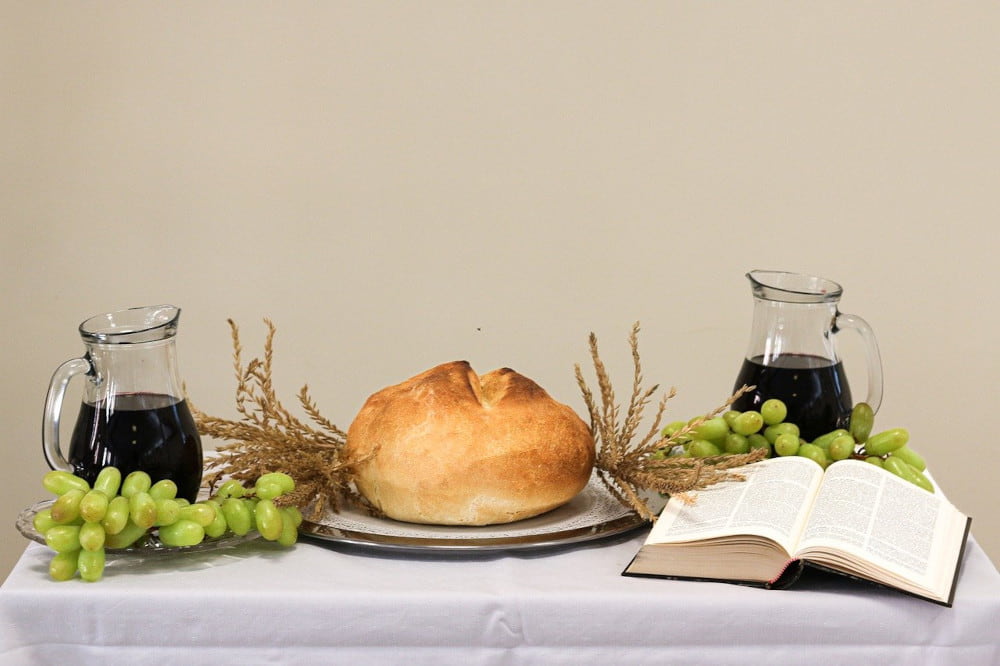
Table of Contents:
This teacher’s copy of the What is Holy Communion – the Last Supper lesson plan is printer-friendly.
RESOURCES:
To perform the Courtroom sketch, these characters need to be found:
- A Judge
- the guilty person
- a policeman
- a narrator
- an unnamed person.
Print off the Courtroom sketch lesson plan!
STARTER:
Imagine receiving a letter from someone very close to you, someone whom you love and admire.
In this letter, there is some very bad news.
They say that they are dying and that this letter may be the last time that they will be able to tell you things.
Q. How important will the rest of the letter be to you?
Discuss.
The last words of someone very close to you are very important.
They haven’t got time for silly things, they want to share what’s on their heart.
MAIN TEACHING:
Christians believe that for a long time, Jesus knew that he was going to die because the religious leaders were jealous of Him.
But more than that, on this particular day, Jesus knew that He was going to be betrayed later that evening and that the Romans would kill Him the next day.
He had spent about three years with this group, training and teaching these people about the Kingdom of God, and proving to them that He was the Son of God by healing people and other miraculous things.
This was the last few hours together before Jesus would leave this earth.
Q. How important was this time together?
So He arranged to have one last meal together with His closest friends, and what He said to them that night was very important.
This is known as the last supper.
(Teachers note: A lot of this teaching is recorded in John 13:1- 17:26. Smaller accounts of that evening are in: Matthew 26:17-35 Mark 14:12-26 and Luke 22:7-38)
The Jewish Passover Meal
But there was something else happening on this very evening, which made this time extremely important.
It was just at the time when all the Israelites would be sharing a yearly event known as the ‘Passover Meal’.
This was in preparation to celebrate the ‘Feast of Passover’ on the next day, and the background of the feast is this:
The Bible tells us that everyone does wrong, they sin, and they rebel against God.
Therefore everyone needs to pay the penalty for this rebellion and pride, and all the wrong things that are done.
And there was no way of stopping the penalty going ahead.
Imagine a Judge announcing the verdict of ‘guilty’ to someone, and then saying; “Don’t worry about it, perhaps the sentence won’t happen after all!”
That wouldn’t be right.
The Law has to do what is right, and justice has to be carried out.
So the Israelites killed a lamb, to illustrate that all these wrong things do have a
consequence.
When bad is done this causes a penalty, which has to be paid for.
In football, if an attacking player is brought down by a defending player in the penalty area, then a penalty has to be taken.
In other words, the penalty for the ‘bad’ tackle is likely to be a goal given away.
But the penalty for rebellion and pride, etc is a lot worse than giving a goal away.
The killing of a lamb couldn’t take away the penalty.
The Judge in the Courtroom
We will now act out: The Courtroom sketch. The sketch will show how big this problem is.
This sketch illustrates that the guilty person cannot pay the penalty.
It required someone very special to come in and pay for it.
But God, as the Judge of the whole world, cannot be paid with money.
No amount of money will redeem a guilty person.
So if money won’t do, nor will sacrificing an animal, what will?
The only way was for someone to take their place.
A substitute to take the blame and punishment
And the Bible tells us that someone is Jesus Christ.
He is a substitute and so He took on the penalty.
Christians believe that because the penalty for sin is spiritual death, (James 1:15)
Jesus Christ died on a Roman cross to pay the penalty for that sin, for everyone who trusts in him.
The Last Supper
So let’s now return to the evening before Jesus was going to die:
He knew who was going to betray him and when, but, because it was all according to God’s plan, he didn’t prevent it from happening.
They began to eat, and Jesus said; “I tell you the truth, one of you will betray me.”
Q. Can you imagine how they would have felt?
Here was a gathering of very close friends, and it made them sad.
They began to think; ‘Does he trust me?’
So they began to say to Him, one after the other, “Surely not I, Lord?”
Jesus replied, “The one who has dipped his hand into the bowl with me will betray me.”
Judas the one who would betray him, was beginning to feel uncomfortable.
He had been feeling more and more disappointed in Jesus.
Perhaps Judas wanted Jesus to rise up and fight against the Roman authorities.
So recently, he had gone to the religious leaders to offer to betray Him.
Their plan was for Judas to lead a group of soldiers to arrest Jesus at night so that the crowds could not stop the arrest.
With all these things racing in Judas’ head, he said, “Surely not I, Teacher?”
Jesus looked straight at him, and answered, “Yes, it is you.”
Judas turned his eyes away.
He was still determined to betray Jesus.
The other people in the room were unaware of the conversation because they were all talking with each other in disbelief that someone would betray Jesus.
They carried on eating, and then Jesus held up a loaf of bread, and the room became very quiet.
He prayed and gave thanks for it.
Then he took hold of it with both hands and he started to brake pieces off of it, and he gave each person a piece. Everyone’s eyes were on him.
Then he said; “Take and eat; this is my body.”
No one dared to ask him what He meant!
They sat in silence and ate it, still watching his every move.
Then he picked up a mug containing wine, and he again prayed and gave thanks for it.
Then he offered it to them, saying, “Drink from it, all of you. This is my blood of the covenant, which is poured out for many for the forgiveness of sins.”
He then went on to explain many things.
Q. Why was Jesus talking about His body being broken, and about His blood being poured out?
Discuss.
It is talking about His death upon a Roman cross.
The bread and wine are symbols of His death.
Jesus, as a substitute, was paying the penalty for sin.
And Christians, by celebrating this meal, are declaring that they believe that Jesus has paid their penalty.
This meal is celebrated in different ways in different churches, but it means the same thing.
It is known by various names; e.g. Eucharist, Holy Communion, Lord’s Supper, Mass.
When it is celebrated, the time is quiet and thoughtful.
Q. Why do you think that time is quiet and thoughtful?
PLENARY:
Q. Do you like to have time to be quiet and thoughtful?
Q. Would it be valuable for you to spend some quiet time alone, to be thoughtful and to think about where your life is taking you?
Either take a short time to discuss these things, or leave it with them.
(Teachers note: There is the Holy Communion worksheet to accompany this
lesson plan.
The Courtroom sketch lesson plan goes with this lesson plan.
See also: What is the Last Supper? RE resources
